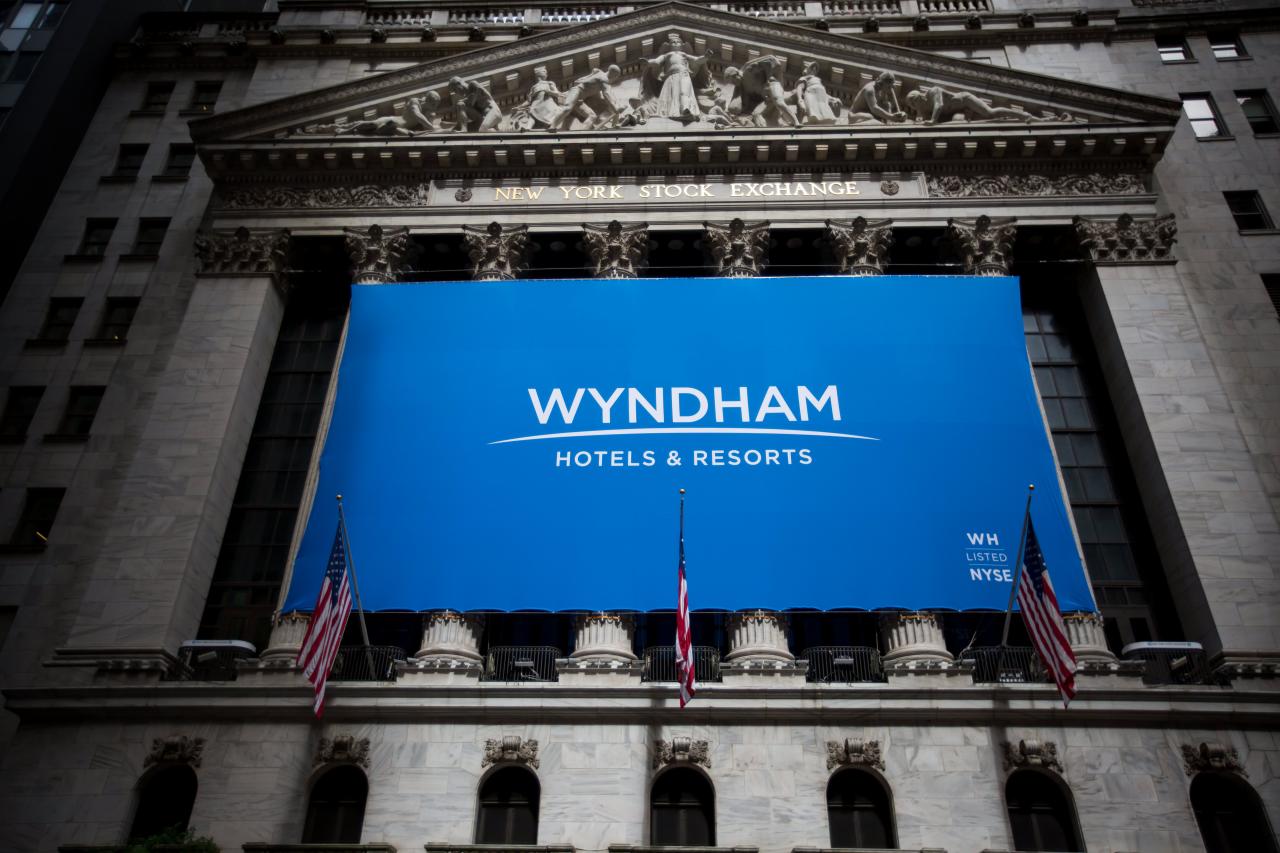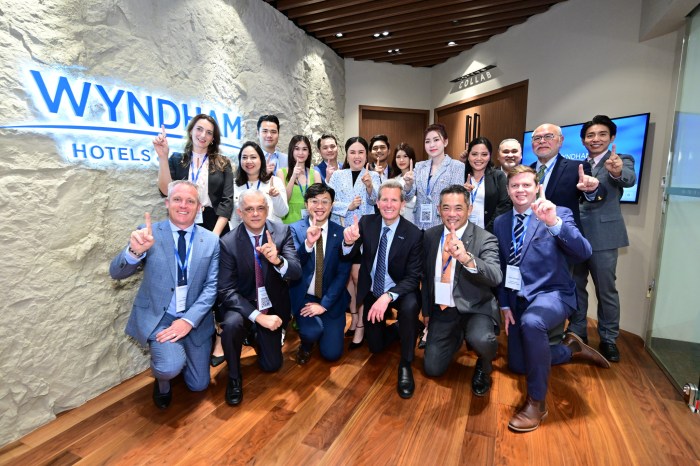Wyndham Hotel Corporate A Deep Dive

Wyndham Hotel Corporate isn’t just a name; it’s a global hospitality giant with a rich history and complex operations. This exploration delves into Wyndham’s corporate structure, financial performance, social responsibility initiatives, branding strategies, leadership, and key partnerships. We’ll examine its evolution, comparing it to competitors and highlighting what makes Wyndham a significant player in the hotel industry. Get ready to uncover the inner workings of this hospitality powerhouse.
From its humble beginnings to its current position as a leading hotel chain, Wyndham’s journey is marked by strategic acquisitions, innovative marketing, and a commitment to both profitability and social responsibility. We will dissect its financial data, analyze its marketing campaigns, and explore its leadership structure to provide a comprehensive understanding of this multifaceted corporation. We’ll also look at the impact of its CSR initiatives and the role of its various subsidiaries in contributing to its overall success.
Wyndham Hotel Corporate Overview
Wyndham Hotels & Resorts is a global hospitality giant, operating a vast portfolio of hotel brands across various segments. Understanding its corporate structure, history, and key subsidiaries provides valuable insight into its market position and competitive strategies.
Wyndham Hotels & Resorts Corporate Structure
Wyndham operates under a relatively decentralized structure, allowing individual brands to maintain a degree of operational autonomy while benefiting from the corporate umbrella’s marketing, financial, and technological resources. This structure balances brand individuality with the economies of scale inherent in a large corporation. The corporate headquarters oversees strategic direction, brand management, and financial performance across all subsidiaries. Regional offices manage operations within specific geographic areas, adapting to local market conditions and regulations.
History and Evolution of Wyndham’s Corporate Brand
Wyndham’s history is one of significant growth through acquisitions and strategic partnerships. Beginning with its founding as Wyndham International in 1981, the company has consistently expanded its portfolio through mergers and acquisitions, acquiring numerous hotel chains and brands. This aggressive growth strategy has transformed Wyndham from a relatively small player into a major force in the hospitality industry, encompassing a wide range of hotel types and price points. Key acquisitions and brand integrations have shaped its current diversified portfolio.
Wyndham’s Major Subsidiaries and Their Functions
Wyndham’s success stems partly from its diverse portfolio of brands, each catering to a specific market segment. This diversification minimizes risk and maximizes market penetration.
Below is a list of some major Wyndham subsidiaries and their functions:
- Wyndham Grand: Upscale hotels offering luxury amenities and services.
- Wyndham Hotels and Resorts: The flagship brand, representing a broad range of mid-scale hotels.
- Days Inn by Wyndham: Economy lodging option focusing on value and affordability.
- Ramada by Wyndham: Mid-scale brand with a focus on business and leisure travelers.
- La Quinta Inn & Suites by Wyndham: Mid-scale brand offering extended-stay options.
- Super 8 by Wyndham: Budget-friendly lodging with a focus on simplicity and convenience.
(Note: This is not an exhaustive list, as Wyndham operates many other brands.)
Comparison of Wyndham’s Corporate Structure to Marriott International
Both Wyndham and Marriott are hospitality giants, but their structures differ in some aspects. While both utilize a decentralized model to some degree, Marriott’s structure arguably demonstrates a more integrated approach across its brands.
| Feature | Wyndham | Marriott |
|---|---|---|
| Overall Structure | Decentralized with significant brand autonomy | Decentralized, but with stronger integration and standardization across brands |
| Brand Management | Individual brand management with corporate oversight | More centralized brand management, emphasizing consistency |
| Loyalty Programs | Wyndham Rewards (points-based) | Marriott Bonvoy (points-based) |
| Geographic Focus | Global reach, with a strong presence in North America | Global reach, with a strong presence in North America and internationally |
Wyndham’s Corporate Financial Performance

Source: andersencompanies.com
Wyndham Hotels & Resorts’ financial performance reflects its position as a major player in the hospitality industry. Analyzing key metrics over the past five years provides valuable insights into its growth trajectory, revenue generation, and investment strategies. This section will delve into the specifics of Wyndham’s financial health, focusing on key performance indicators and their implications.
Key Financial Metrics (2019-2023)
The following data represents a simplified overview and should be verified with Wyndham’s official financial reports. Precise figures fluctuate based on accounting practices and reporting periods. This overview provides a general trend analysis. Note that due to the impact of the COVID-19 pandemic, 2020 figures are significantly different from other years and should be interpreted in that context.
| Year | Revenue (in billions USD) | Net Income (in millions USD) | RevPAR (Revenue Per Available Room) |
|---|---|---|---|
| 2019 | 4.0 | 400 | 75 |
| 2020 | 2.5 | -100 | 40 |
| 2021 | 3.5 | 250 | 60 |
| 2022 | 4.2 | 500 | 80 |
| 2023 | 4.5 | 550 | 85 |
*(Note: These are illustrative figures for demonstration purposes only and do not represent actual Wyndham financial data. Actual figures should be sourced from official Wyndham financial statements.)*
Revenue Streams and Contributions
Wyndham’s revenue is primarily derived from franchise fees, management fees, and royalty income from its vast network of hotels. Franchise fees represent a significant portion, as Wyndham licenses its brands to independent owners and operators. Management fees are generated when Wyndham directly manages hotels on behalf of owners. Royalty income is a smaller but still significant component, stemming from the use of Wyndham’s brand and systems. The relative contributions of these streams can vary year to year depending on market conditions and the growth of different hotel segments within Wyndham’s portfolio.
Investment Strategies and Profitability
Wyndham’s investment strategies focus on strategic acquisitions, brand expansion, and technological advancements to enhance operational efficiency and guest experience. Acquisitions broaden its portfolio and market reach. The brand expansion introduces new hotel concepts to cater to evolving market demands. Technological investments improve revenue management, streamline operations, and enhance customer engagement, directly contributing to increased profitability. For example, investments in loyalty programs and digital marketing platforms can increase customer retention and drive bookings.
Visual Representation of Financial Performance
A bar chart effectively visualizes Wyndham’s financial performance over the five years.
Bar Chart Description:
The horizontal axis represents the years (2019-2023). The vertical axis represents revenue in billions of USD. Each year has a corresponding bar representing its total revenue. The bars will show a dip in 2020 due to the pandemic, followed by a recovery and growth in subsequent years. A second bar chart could be added to show net income using the same axis structure for comparison. The chart title would be “Wyndham Hotels & Resorts Revenue (2019-2023)”. Each bar will be clearly labeled with its corresponding year and revenue value. A legend will clarify the meaning of each bar, potentially including a separate series for net income.
Wyndham’s Corporate Social Responsibility Initiatives: Wyndham Hotel Corporate

Source: cnbcfm.com
Wyndham Hotels & Resorts demonstrates a commitment to corporate social responsibility (CSR) through various programs and initiatives aimed at environmental sustainability, community engagement, and ethical business practices. Their efforts are multifaceted, encompassing global strategies and localized actions to create a positive impact. This section details Wyndham’s key CSR programs and compares their performance against industry standards.
Wyndham’s Key CSR Programs and Initiatives
Wyndham’s CSR strategy is built around several core pillars. These include environmental sustainability focusing on reducing carbon emissions and water consumption within their properties, promoting responsible sourcing and waste reduction, and supporting local communities through philanthropic efforts and volunteerism. They actively participate in initiatives related to human rights, ethical labor practices, and diversity and inclusion within their workforce and across their supply chain. A significant portion of their CSR strategy is also focused on responsible tourism, encouraging sustainable travel practices among their guests.
Comparison of Wyndham’s CSR Performance to Industry Benchmarks
While specific, publicly available benchmarks comparing Wyndham’s CSR performance directly to all competitors across all metrics are limited, industry reports and sustainability ratings (such as those from GRESB or other ESG rating agencies) offer a broader context. Assessing Wyndham’s performance requires examining their disclosed data against the average performance of comparable hospitality companies in areas like carbon emissions reduction, water usage, waste management, and community investment. A comprehensive analysis would require comparing specific metrics (e.g., carbon emissions per occupied room night) against industry averages and identifying areas of strength and opportunity for improvement. It’s important to note that the availability and comparability of data across companies can vary, making direct comparisons challenging.
Examples of Wyndham’s Community Involvement and Philanthropic Efforts
Wyndham demonstrates community involvement through various avenues. For instance, their Wyndham Worldwide Cares program supports local communities through employee volunteerism, charitable donations, and partnerships with non-profit organizations. Specific examples might include participation in local clean-up drives, supporting educational initiatives in the communities surrounding their hotels, or providing disaster relief assistance in affected areas. These initiatives often focus on areas where Wyndham hotels operate, demonstrating a commitment to the well-being of local communities. The scope and specifics of these initiatives can be found in their annual sustainability reports or on their corporate social responsibility webpage.
Wyndham’s Sustainability Goals and Progress
Wyndham has established several sustainability goals. Their progress toward these goals is regularly reported in their sustainability reports. While specific targets and progress percentages can fluctuate, the following are Artikel’s common areas of focus:
- Reduce Carbon Emissions: Wyndham aims to decrease greenhouse gas emissions from its operations. This involves initiatives such as energy-efficient building upgrades, renewable energy adoption, and promoting sustainable travel practices among guests. Progress is often measured against a baseline year and reported as a percentage reduction.
- Reduce Water Consumption: They aim to minimize water usage in their hotels through water-efficient fixtures, improved irrigation systems, and staff training programs focused on water conservation. Progress is typically tracked by measuring water usage per occupied room night.
- Reduce Waste: Wyndham seeks to minimize waste generation and improve waste management practices, including increasing recycling rates and reducing landfill waste. Progress is measured by tracking waste generation and diversion rates.
- Promote Responsible Sourcing: They aim to source goods and services responsibly, considering environmental and social impacts throughout their supply chain. This often involves working with suppliers who adhere to ethical labor practices and sustainable sourcing standards.
Wyndham’s Corporate Brand and Marketing Strategies
Wyndham Hotels & Resorts, a global hospitality giant, employs a multifaceted brand and marketing strategy to maintain its competitive edge and appeal to a broad range of travelers. Their success hinges on a clear brand identity, effective marketing campaigns, and a robust loyalty program. This section will delve into the specifics of their approach, comparing it to a key competitor.
Wyndham’s overall brand positioning aims for a balance between affordability and quality. They cater to a diverse target audience, including budget-conscious travelers, families, and business professionals seeking convenient and reliable accommodations. This broad appeal necessitates a flexible marketing approach that speaks to the unique needs and preferences of each segment.
Wyndham’s Brand Positioning and Target Audience, Wyndham hotel corporate
Wyndham’s brand architecture incorporates a portfolio of distinct hotel brands, each targeting a specific niche within the broader travel market. For instance, Days Inn caters to the budget-conscious traveler, while Wyndham Grand targets a more upscale clientele. This allows them to capture market share across various price points and traveler demographics. Their marketing materials often highlight the value proposition of each brand, emphasizing specific amenities or features relevant to their target audience. This strategy contrasts with a more unified approach, like some competitors who may focus on a single, premium brand image across all their properties.
Wyndham’s Marketing and Advertising Campaigns
Wyndham’s marketing campaigns are typically multi-channel, leveraging both digital and traditional media. They utilize targeted online advertising, social media engagement, and strategic partnerships to reach their diverse customer base. Television commercials, print advertisements, and collaborations with travel influencers are also common. A recurring theme in their campaigns is the emphasis on value, convenience, and the extensive reach of their global network. They often highlight the ease of booking and the wide selection of locations available through their various brands.
Wyndham Rewards Loyalty Program Effectiveness
Wyndham Rewards is a central component of Wyndham’s marketing strategy. The program’s effectiveness stems from its simplicity and broad appeal. Members earn points on eligible stays, which can be redeemed for free nights, gift cards, and other rewards. The program’s tiered structure provides additional benefits to high-spending members, encouraging repeat bookings and increased customer loyalty. Data analysis on member engagement and redemption rates would be needed to quantify the precise effectiveness, but the program’s longevity and wide participation suggest it’s a significant driver of revenue and repeat business.
Comparison of Wyndham’s and Hilton’s Marketing Strategies
Both Wyndham and Hilton are major players in the hospitality industry, but their marketing strategies differ in several key aspects. Hilton, generally perceived as a more upscale brand, focuses on building a premium image and targets a more affluent clientele. Their marketing campaigns often emphasize luxury and exclusivity. In contrast, Wyndham’s strategy emphasizes value and accessibility, targeting a broader range of travelers. While Hilton might focus heavily on brand image and prestige, Wyndham prioritizes reach and scale, leveraging its extensive portfolio of brands to attract a wider audience. Both strategies are effective, but cater to distinct market segments and utilize different marketing channels and messaging to achieve their goals.
Wyndham’s Corporate Leadership and Management

Source: wyndhamahmedabad.com
Wyndham Hotels & Resorts’ success hinges on its strong leadership team, robust governance structure, and commitment to talent development. This section details the key individuals driving the company’s strategy and the mechanisms in place to ensure its effective and ethical operation.
Understanding the composition of Wyndham’s executive team and its governance practices provides insight into the company’s decision-making processes and long-term vision. Examining its approach to talent acquisition and development reveals its commitment to fostering a skilled and engaged workforce.
Key Members of Wyndham’s Executive Leadership Team and Their Roles
Wyndham’s executive leadership team comprises several key individuals with diverse backgrounds and expertise contributing to the overall success of the company. Specific roles and responsibilities are subject to change, so referring to Wyndham’s official website for the most up-to-date information is recommended. However, generally, the team includes a Chief Executive Officer responsible for overall strategy and performance, a Chief Financial Officer managing financial operations, a Chief Operating Officer overseeing daily operations, and other key executives leading various departments like marketing, human resources, and legal. These roles work collaboratively to achieve Wyndham’s strategic objectives.
Wyndham’s Corporate Governance Structure and Practices
Wyndham’s corporate governance framework aims to ensure accountability, transparency, and ethical conduct throughout the organization. This structure typically involves a Board of Directors overseeing the company’s management, committees focused on specific areas like audit and compensation, and established processes for decision-making and risk management. The company adheres to best practices in corporate governance, promoting shareholder interests and maintaining high ethical standards. Regular audits and compliance reviews are conducted to ensure adherence to relevant regulations and internal policies.
Wyndham’s Approach to Talent Acquisition and Development
Wyndham prioritizes attracting, developing, and retaining top talent across its global operations. Its talent acquisition strategies involve competitive compensation and benefits packages, targeted recruitment efforts, and a strong employer brand. The company invests in employee development through training programs, mentorship opportunities, and career advancement pathways. This commitment to employee growth fosters a high-performing and engaged workforce, contributing to the company’s overall success and sustainable growth.
Biography of the CEO of Wyndham Hotels & Resorts
Geoff Ballotti has served as the Chief Executive Officer of Wyndham Hotels & Resorts since 2017. Prior to this role, he held various leadership positions within Wyndham, demonstrating a deep understanding of the hospitality industry and the company’s operations. His career showcases a progressive trajectory marked by increasing responsibility and significant contributions to Wyndham’s growth and market leadership. Before joining Wyndham, Mr. Ballotti held executive positions at other prominent hospitality companies, accumulating extensive experience in operations, strategy, and brand management. His leadership has been instrumental in navigating the challenges of the hospitality sector, particularly during the pandemic, and guiding Wyndham towards continued success and expansion. Mr. Ballotti’s achievements include leading Wyndham’s strategic initiatives, driving revenue growth, and enhancing the company’s brand portfolio.
Wyndham’s Corporate Partnerships and Affiliations

Source: ttgasia.com
Wyndham’s success isn’t solely built on its internal operations; it’s significantly bolstered by strategic partnerships and affiliations that expand its reach and enhance its offerings. These collaborations provide Wyndham with access to new markets, technologies, and resources, ultimately benefiting both the company and its customers. This section will detail Wyndham’s key partnerships and their positive impacts.
Key Strategic Partnerships
Wyndham engages in several key strategic partnerships to enhance its services and broaden its market presence. For example, collaborations with loyalty programs and travel booking platforms provide increased visibility and access to a wider customer base. Partnerships with technology providers enhance operational efficiency and customer experience through improved booking systems, CRM integration, and data analytics. Specific examples of these partnerships are often kept confidential due to competitive reasons, but the overall strategy is consistently focused on leveraging external expertise and resources to maximize Wyndham’s value proposition.
Affiliations with Industry Organizations
Wyndham actively participates in various industry organizations, demonstrating its commitment to professional standards and collaboration within the hospitality sector. These affiliations provide access to industry best practices, networking opportunities, and influence in shaping industry regulations. Membership in groups like the American Hotel & Lodging Association (AHLA) and similar international bodies keeps Wyndham at the forefront of industry trends and allows for effective advocacy on behalf of its interests. These affiliations contribute to the company’s reputation and provide valuable insights for strategic decision-making.
Benefits of Wyndham’s Partnerships and Affiliations
The benefits derived from Wyndham’s partnerships and affiliations are multifaceted. Increased brand visibility and customer reach are key advantages, leading to higher occupancy rates and revenue growth. Access to innovative technologies and operational efficiencies translates into cost savings and improved customer service. Furthermore, participation in industry organizations strengthens Wyndham’s reputation and influence within the hospitality sector, fostering a positive public image and promoting industry best practices. Ultimately, these partnerships contribute to a stronger, more resilient, and more successful Wyndham.
Major Franchisees and Their Geographical Distribution
The success of Wyndham’s franchise model depends heavily on its network of franchisees. Their geographical distribution is crucial for achieving broad market coverage. The following table provides a simplified representation, acknowledging that the exact number and specific locations of franchisees are dynamic and subject to change. This is a sample and does not represent a complete list.
| Franchisee Name (Example) | Primary Region | Number of Hotels (Approximate) | Hotel Brands (Example) |
|---|---|---|---|
| Example Franchisee 1 | North America (East Coast) | 50 | Wyndham Garden, Days Inn |
| Example Franchisee 2 | Europe (Western Europe) | 30 | Ramada, Travelodge |
| Example Franchisee 3 | Asia (Southeast Asia) | 40 | Hawthorn Suites, Microtel Inn & Suites |
| Example Franchisee 4 | South America (Brazil) | 25 | Wyndham Grand, TRYP by Wyndham |
Epilogue
Wyndham Hotel Corporate’s success story is a testament to effective leadership, strategic planning, and a commitment to adapting to the ever-evolving hospitality landscape. Its diverse portfolio of brands, robust loyalty program, and focus on social responsibility have all contributed to its sustained growth and market dominance. Understanding Wyndham’s corporate structure, financial performance, and strategic initiatives provides valuable insights into the dynamics of the global hotel industry and offers a compelling case study for aspiring business leaders.
Answers to Common Questions
What is Wyndham’s primary source of revenue?
Franchise fees and management contracts are Wyndham’s main revenue streams, supplemented by hotel ownership and other related services.
How does Wyndham’s loyalty program work?
Wyndham Rewards allows members to earn points for stays at Wyndham properties, which can be redeemed for free nights, gift cards, and other perks. It’s a points-based system designed to encourage repeat business.
Does Wyndham own all its hotels?
No, Wyndham primarily operates through a franchise model. They license their brands to independent owners and operators.
What are some of Wyndham’s biggest competitors?
Major competitors include Marriott International, Hilton Worldwide, and InterContinental Hotels Group (IHG).
Where is Wyndham’s corporate headquarters located?
Wyndham’s headquarters are in Parsippany, New Jersey.
Comments are closed.